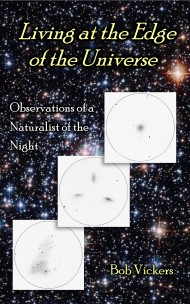I have added twelve sketches to my Galaxy Groups & Clusters page, beginning with Additional Galaxy Group #1 (AKA IC5370 group). This is a small, irregular chain of five galaxies, all of which were only visible with averted vision.

GG&C Additional #1 – Copyright (c) 2015 Robert D. Vickers, Jr.
Next is Hickson 99, a fairly tight grouping of five galaxies of which I was able to see three. The B component (U12899) was visible with direct vision, while the A component only showed as a dim, very elongated north/south streak with a dim field star near the southern tip.

GG&C Hickson #99 – Copyright (c) 2015 Robert D. Vickers, Jr.
Hickson 100 showed me two of its four components. The brightest member, visible with direct vision, is NGC 7803, which has a large, elongated halo running east/west. It becomes brighter toward the center and has a dim stellar nucleus.

GG&C Hickson #100 – Copyright (c) 2015 Robert D. Vickers, Jr.
Additional Galaxy Group #2 (the NGC 3 group) consists of five galaxies in a scattered grouping, all of which are averted vision objects. NGC 3 is the brightest member. It is elongated east/west, becomes brighter toward the center, and has a dim stellar nucleus.

GG&C Additional #2 – Copyright (c) 2015 Robert D. Vickers, Jr.
Additional Galaxy Group #3 is a fairly tight but uneven group of ten galaxies of which I managed to view eight. It consists of a couple of brighter galaxies and several dimmer ones, all visible only with averted vision.

GG&C Additional #3 – Copyright (c) 2015 Robert D. Vickers, Jr.
I viewed the Trio #13 (NGC 2379 Trio) earlier this year and it turned out to be a bit more difficult than I had anticipated. NGC 2379 (small and concentrated) was easy enough as a direct vision object, but the two other galaxies in this string, NGC 2375 and NGC 2373, were very hazy and diffuse spots. All three seemed dimmer than the listed magnitudes.

GG&C Trio 13 – Copyright (c) 2015 Robert D. Vickers, Jr.
Abell #14 (569) is a rather large and loose cluster. I observed the “center” of this cluster, which is a crooked string of one or two brighter galaxies and several dimmer ones. The two brightest galaxies are NGC 2329 (which has an elongated halo running north-northeast/south-southwest with a brighter core and a dim stellar nucleus) and UGC 3696 (which is smaller but also has an elongated halo running northeast/southwest).

GG&C Abell #14 (569) – Copyright (c) 2015 Robert D. Vickers, Jr.
I was able to observe seven out of the nine galaxies in Additional Group #12 (NGC 2340 group), a “U” shaped string of galaxies with one bright NGC galaxy (NGC 2340) and six dimmer IC galaxies. NGC 2340 is fairly large and bright with an elliptical halo, a bright elongated core, and a dim stellar nucleus.

GG&C Additional #12 – Copyright (c) 2015 Robert D. Vickers, Jr.
I could only spot a handful of galaxies in the Abell #15 (576) Cluster. They are just a scattering of five very dim galaxies visible only with extreme averted vision. I am also unsure of the designations for a couple of them.

GG&C Abell #15 (576) – Copyright (c) 2015 Robert D. Vickers, Jr.
Abell #22 (1185) is a large cluster of 82 or more galaxies with a clump of brighter galaxies toward the middle. Its distance is listed as around 433 million lightyears. The only direct vision galaxy is NGC 3550. It is a large, roundish cloud with no nucleus and fairly even in brightness. NGC 3561 and NGC 3561A together are part of Arp 105 (The Guitar). I could not see any other detail of The Guitar. Nor could I see another feature called Ambartsumian’s knot (a small tidal dwarf galaxy at the base of The Guitar). (See Astronomy Picture of the Day (APOD) for 22 November 2005.)

GG&C Abell #22 (1185) – Copyright (c) 2015 Robert D. Vickers, Jr.
I viewed three of the Hickson 84 galaxies, a very dim and compact group.

GG&C Hickson #84 – Copyright (c) 2015 Robert D. Vickers, Jr.
Abell #38 (2151) (AKA the Hercules Cluster of Galaxies) is a bit overwhelming due to the shear number of galaxies (87 listed). I concentrated on the center, a long rectangular group of fairly dim galaxies. Although these are the brighter galaxies for the most part, they are still at least an AV3 (object seen more than 50% of the time) or dimmer. I will have to revisit this cluster in the future and try to pick off some more faint fuzzies.

GG&C Abell #38 (2151) – Copyright (c) 2015 Robert D. Vickers, Jr.

